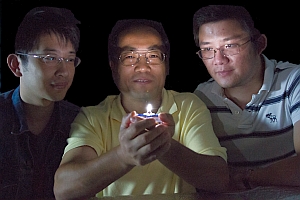
Zhengwei Pan, center, demonstrates a prototype of the new LED bulb, with colleagues Feng Liu, left, and Xufan Li (University of Georgia) Zhengwei Pan, center, demonstrates a prototype of the new LED bulb, with colleagues Feng Liu, left, and Xufan Li (University of Georgia)
Researchers from the U.S. and China created a light-emitting diode (LED) bulb that emits warm white light with a single light-emitting phosphor. The findings of University of Georgia physicist Zhengwei Pan, with colleagues from Georgia, Georgia Southern University, Oak Ridge National Lab, Argonne National Lab, and the Chinese Academy of Sciences, were published online today in the journal Light: Science and Applications.
LEDs are known for their energy efficiency and durability, but also for a cold, bluish white light that distorts colors and discourages widespread use for indoor lighting. The temperature of lighting is calculated with a measure known as kelvins. One factor in lighting termperature is correlated color temperature that measures the coolness or warmth of a light, and temperatures of less than 4,000 kelvins are considered ideal for indoor lighting. White LEDs, however, give off correlated color temperatures above 5,000 kelvins, resulting in their characteristic bluish color.
Another variable, color rendition, is the ability of a light source to replicate natural light. A color rendition index value of more than 80 is ideal for indoor lighting, with lower values resulting in color distortions.
To achieve warm white light with LEDs normally requires coating light emitting materials, or phosphors, of different colors to create what are called phosphor-based white LEDs. This process, however, is costly and often does not give consistent color output because the source materials responds differently to temperature variations. “The use of a single phosphor solves the problem of color stability because the color quality doesn’t change with increasing temperatures,” says lead author Xufan Li, an engineering doctoral candidate.
To create the new phosphor, the researchers combined small quantities of europium oxide with aluminum oxide, barium oxide and graphite powders. They then heated the powders at 1,450 degrees C (2,642 F) in a tube furnace. A vacuum created in the furnace pulled the vaporized materials onto a substrate, and deposited the vapors as a yellow luminescent compound.
That yellow luminescent compound was then encapsulated in a bulb and illuminated by a blue LED chip, creating a warm white light. The phosphor material developed by Pan and colleagues meets the desirable targets for both color temperature factors: a correlated color temperature of less than 4,000 kelvins and color rendering index of 85.
“Our material,” says Pan, “achieves a warm color temperature while at the same time giving highly accurate color rendition, which is something no single-phosphor-converted LED has ever been shown to do.”
The phosphor material and process for producing the material, Pan notes, are still not ready for the commercial market. The efficiency of the new material is much lower than that of today’s white LEDs. In addition, increasing production to an industrial scale first needs to meet the challenge of even small variations in temperature and pressure in the phosphor synthesis process can result in materials with different luminescent colors.
“We still have more work to do,” says Pan, “but the color temperature and rendition that we have achieved gives us a very good starting point.”
Read more:
- Nanotech Lights Improve on Fluorescent, LED, CFL Bulbs
- LED Bulbs Edge CFLs for Environmental Friendliness
- University, Company Boost LC Projector Energy Efficiency
- Smart Headlights Help Drivers See Better in the Rain
- Nanotech Method Devised for Capturing Firefly Light
* * *

 RSS - Posts
RSS - Posts
You must be logged in to post a comment.